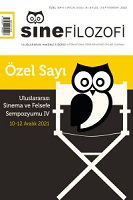Tarkovski Sinemasında Düşünceye Dönüşen Resim: Deleuze ve Artaud’nun Görüşleri Üzerinden Yeni Bir Analiz
Picture Transformed into Thought in Tarkovsky Cinema: A New Analysis on the Views of Deleuze and Artaud
Author(s): Ahmet Fatih YılmazSubject(s): Aesthetics, Contemporary Philosophy, Film / Cinema / Cinematography, Sociology of Art, History of Art
Published by: Serdar Öztürk
Keywords: Tarkovsky; Deleuze; Artaud; Thought; Painting; Cinema;
Summary/Abstract: In this study, the paintings encountered in Andrey Tarkovsky’s films are discussed in the light of Gilles Deleuze’s concept of “Time-Image” and Antonin Artaud’s concepts of “violence cinema”, “vibration” and “shock effect”. Deleuze, who has subjected the history of cinema to a new taxonomy as before and after the Second World War, argues that the post-war cinema is the Time-Image cinema. While time was dependent on motion in the first period of cinema, after the war a cinematic understanding developed in which motion was subject to time. Deleuze’s idea of time-first cinema derives from the ideas of Tarkovsky as well as from Henri Bergson. The Time-Image period begins with the MovementImage Crisis and then undergoes a continuous transformation with the productions of new directors. Tarkovsky’s films are in the Time-Image period. If war is to be talked about in his cinema, anti-war ideas should be ignited, not guns. He does this with Albrecht Dürer’s engravings of “Apocalypse” in Ivan’s Childhood. Artaud’s brutal cinema is exactly like that. Encounters with pictures have the function of breaking the sensory-motor habits of the viewer. According to Tarkovsky, when one encounters a masterpiece, one begins to hear that voice that inspired the artist. Such moments, when the audience is deeply shaken and shocked, almost provide a spiritual cleansing. For example, the paintings of Leonardo Da Vinci are like this. The faces he paints bear the traces of lofty thoughts. From the beginning to the end of his career, Tarkovsky continued to include paintings by different artists, especially Renaissance European artists. He uses the paintings to create the “reflective shock” effect in the films Andrey Rublev, Solaris, Mirror, Nostalghia, Stalker and Kurban, respectively. Pictures make people who stopped believing in the world believe again. According to Deleuze, this is one of the most distinctive features of modern cinema.
Journal: SineFilozofi
- Issue Year: 7/2022
- Issue No: Sp. Iss.
- Page Range: 87-105
- Page Count: 19
- Language: Turkish

